Different Forms of Companies and Organizational Structure
VerifiedAdded on 2022/11/29
|9
|2721
|406
AI Summary
This report explores the different forms of companies, including micro, small, medium-sized, and large businesses. It also discusses the organizational structure and its importance in defining roles and responsibilities. Additionally, the report examines the impact of external factors on business performance, such as political, economic, social, technological, legal, and environmental influences. Examples and case studies are provided throughout the report.
Contribute Materials
Your contribution can guide someone’s learning journey. Share your
documents today.
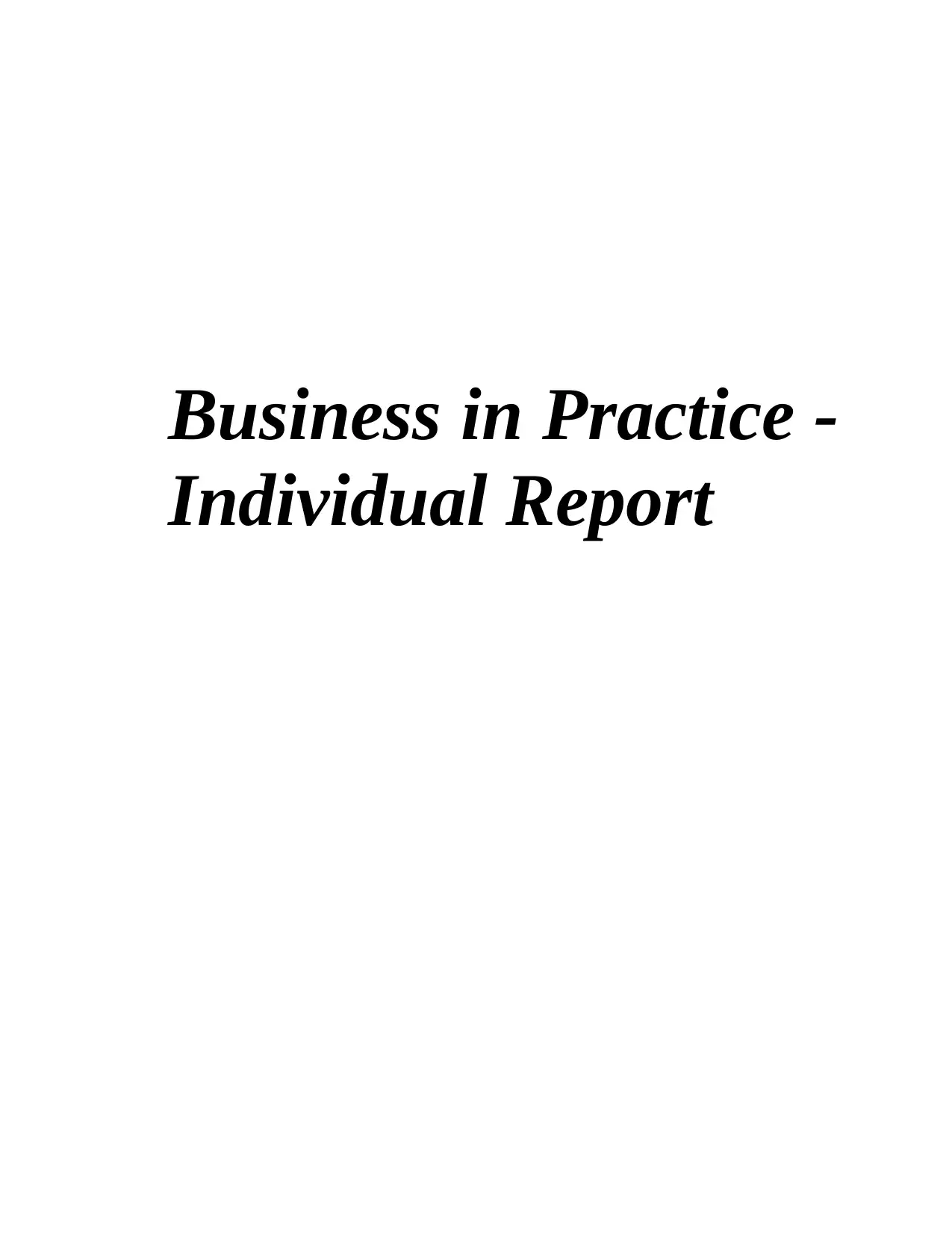
Business in Practice -
Individual Report
Individual Report
Secure Best Marks with AI Grader
Need help grading? Try our AI Grader for instant feedback on your assignments.
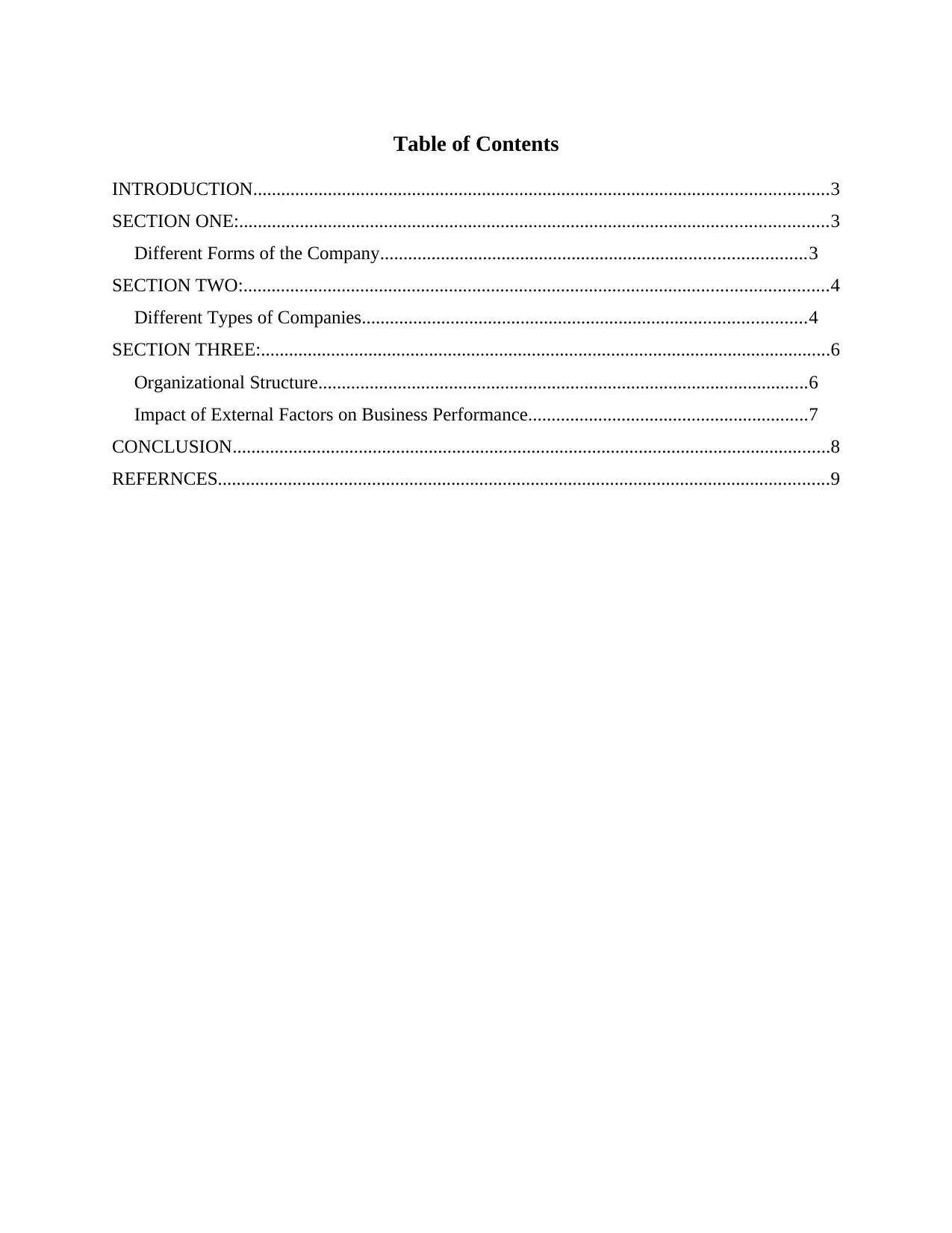
Table of Contents
INTRODUCTION...........................................................................................................................3
SECTION ONE:..............................................................................................................................3
Different Forms of the Company...........................................................................................3
SECTION TWO:.............................................................................................................................4
Different Types of Companies...............................................................................................4
SECTION THREE:..........................................................................................................................6
Organizational Structure.........................................................................................................6
Impact of External Factors on Business Performance............................................................7
CONCLUSION................................................................................................................................8
REFERNCES...................................................................................................................................9
INTRODUCTION...........................................................................................................................3
SECTION ONE:..............................................................................................................................3
Different Forms of the Company...........................................................................................3
SECTION TWO:.............................................................................................................................4
Different Types of Companies...............................................................................................4
SECTION THREE:..........................................................................................................................6
Organizational Structure.........................................................................................................6
Impact of External Factors on Business Performance............................................................7
CONCLUSION................................................................................................................................8
REFERNCES...................................................................................................................................9
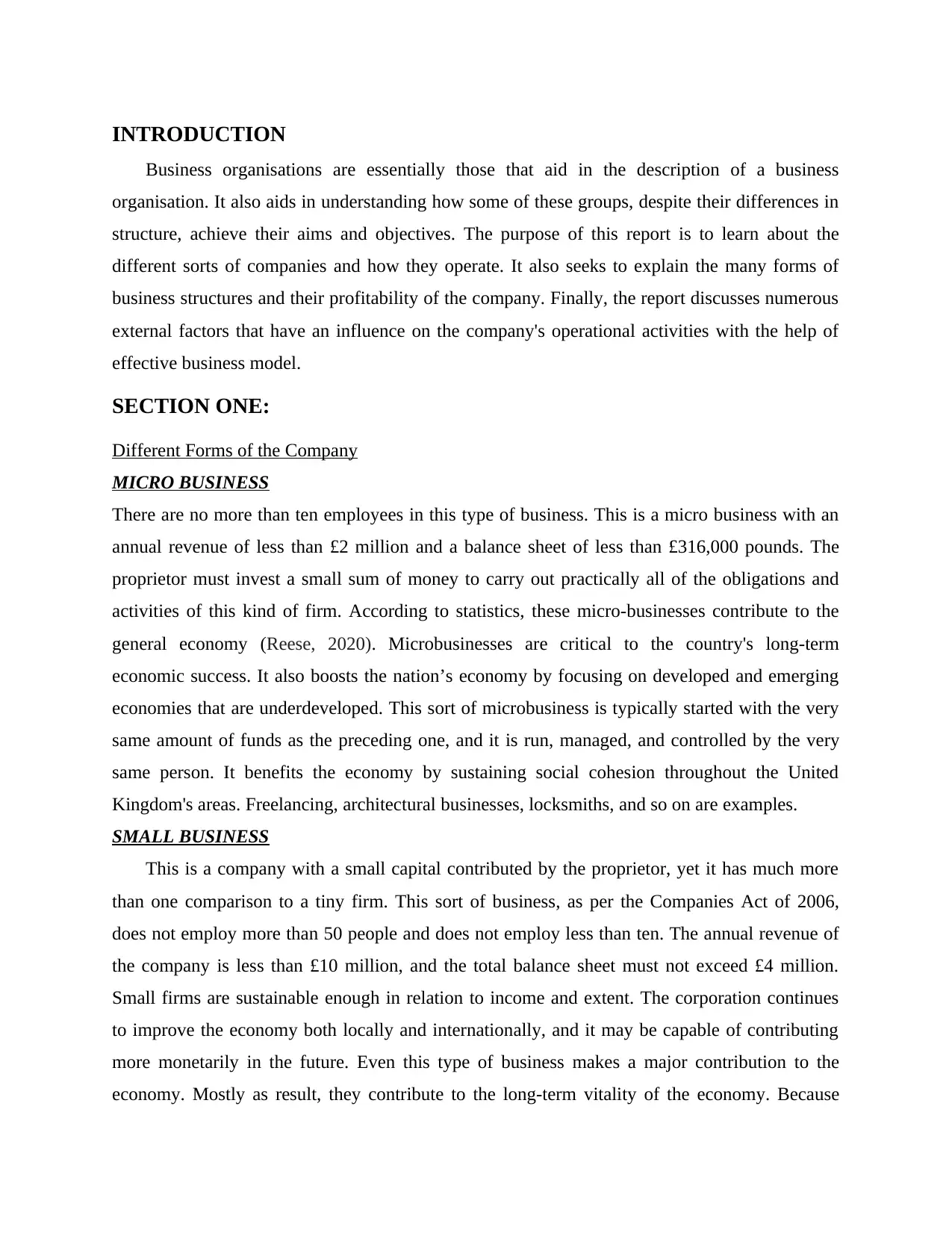
INTRODUCTION
Business organisations are essentially those that aid in the description of a business
organisation. It also aids in understanding how some of these groups, despite their differences in
structure, achieve their aims and objectives. The purpose of this report is to learn about the
different sorts of companies and how they operate. It also seeks to explain the many forms of
business structures and their profitability of the company. Finally, the report discusses numerous
external factors that have an influence on the company's operational activities with the help of
effective business model.
SECTION ONE:
Different Forms of the Company
MICRO BUSINESS
There are no more than ten employees in this type of business. This is a micro business with an
annual revenue of less than £2 million and a balance sheet of less than £316,000 pounds. The
proprietor must invest a small sum of money to carry out practically all of the obligations and
activities of this kind of firm. According to statistics, these micro-businesses contribute to the
general economy (Reese, 2020). Microbusinesses are critical to the country's long-term
economic success. It also boosts the nation’s economy by focusing on developed and emerging
economies that are underdeveloped. This sort of microbusiness is typically started with the very
same amount of funds as the preceding one, and it is run, managed, and controlled by the very
same person. It benefits the economy by sustaining social cohesion throughout the United
Kingdom's areas. Freelancing, architectural businesses, locksmiths, and so on are examples.
SMALL BUSINESS
This is a company with a small capital contributed by the proprietor, yet it has much more
than one comparison to a tiny firm. This sort of business, as per the Companies Act of 2006,
does not employ more than 50 people and does not employ less than ten. The annual revenue of
the company is less than £10 million, and the total balance sheet must not exceed £4 million.
Small firms are sustainable enough in relation to income and extent. The corporation continues
to improve the economy both locally and internationally, and it may be capable of contributing
more monetarily in the future. Even this type of business makes a major contribution to the
economy. Mostly as result, they contribute to the long-term vitality of the economy. Because
Business organisations are essentially those that aid in the description of a business
organisation. It also aids in understanding how some of these groups, despite their differences in
structure, achieve their aims and objectives. The purpose of this report is to learn about the
different sorts of companies and how they operate. It also seeks to explain the many forms of
business structures and their profitability of the company. Finally, the report discusses numerous
external factors that have an influence on the company's operational activities with the help of
effective business model.
SECTION ONE:
Different Forms of the Company
MICRO BUSINESS
There are no more than ten employees in this type of business. This is a micro business with an
annual revenue of less than £2 million and a balance sheet of less than £316,000 pounds. The
proprietor must invest a small sum of money to carry out practically all of the obligations and
activities of this kind of firm. According to statistics, these micro-businesses contribute to the
general economy (Reese, 2020). Microbusinesses are critical to the country's long-term
economic success. It also boosts the nation’s economy by focusing on developed and emerging
economies that are underdeveloped. This sort of microbusiness is typically started with the very
same amount of funds as the preceding one, and it is run, managed, and controlled by the very
same person. It benefits the economy by sustaining social cohesion throughout the United
Kingdom's areas. Freelancing, architectural businesses, locksmiths, and so on are examples.
SMALL BUSINESS
This is a company with a small capital contributed by the proprietor, yet it has much more
than one comparison to a tiny firm. This sort of business, as per the Companies Act of 2006,
does not employ more than 50 people and does not employ less than ten. The annual revenue of
the company is less than £10 million, and the total balance sheet must not exceed £4 million.
Small firms are sustainable enough in relation to income and extent. The corporation continues
to improve the economy both locally and internationally, and it may be capable of contributing
more monetarily in the future. Even this type of business makes a major contribution to the
economy. Mostly as result, they contribute to the long-term vitality of the economy. Because
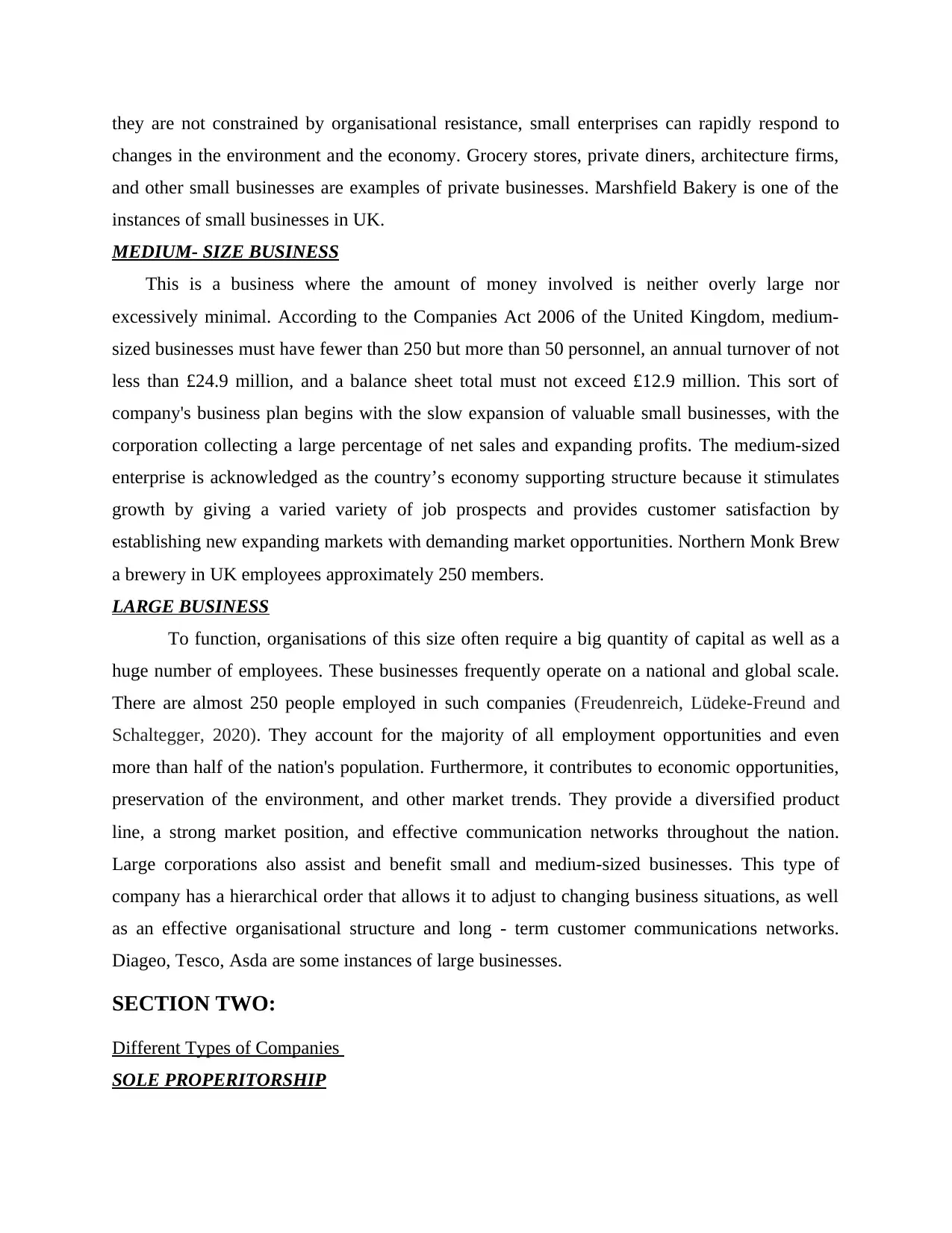
they are not constrained by organisational resistance, small enterprises can rapidly respond to
changes in the environment and the economy. Grocery stores, private diners, architecture firms,
and other small businesses are examples of private businesses. Marshfield Bakery is one of the
instances of small businesses in UK.
MEDIUM- SIZE BUSINESS
This is a business where the amount of money involved is neither overly large nor
excessively minimal. According to the Companies Act 2006 of the United Kingdom, medium-
sized businesses must have fewer than 250 but more than 50 personnel, an annual turnover of not
less than £24.9 million, and a balance sheet total must not exceed £12.9 million. This sort of
company's business plan begins with the slow expansion of valuable small businesses, with the
corporation collecting a large percentage of net sales and expanding profits. The medium-sized
enterprise is acknowledged as the country’s economy supporting structure because it stimulates
growth by giving a varied variety of job prospects and provides customer satisfaction by
establishing new expanding markets with demanding market opportunities. Northern Monk Brew
a brewery in UK employees approximately 250 members.
LARGE BUSINESS
To function, organisations of this size often require a big quantity of capital as well as a
huge number of employees. These businesses frequently operate on a national and global scale.
There are almost 250 people employed in such companies (Freudenreich, Lüdeke-Freund and
Schaltegger, 2020). They account for the majority of all employment opportunities and even
more than half of the nation's population. Furthermore, it contributes to economic opportunities,
preservation of the environment, and other market trends. They provide a diversified product
line, a strong market position, and effective communication networks throughout the nation.
Large corporations also assist and benefit small and medium-sized businesses. This type of
company has a hierarchical order that allows it to adjust to changing business situations, as well
as an effective organisational structure and long - term customer communications networks.
Diageo, Tesco, Asda are some instances of large businesses.
SECTION TWO:
Different Types of Companies
SOLE PROPERITORSHIP
changes in the environment and the economy. Grocery stores, private diners, architecture firms,
and other small businesses are examples of private businesses. Marshfield Bakery is one of the
instances of small businesses in UK.
MEDIUM- SIZE BUSINESS
This is a business where the amount of money involved is neither overly large nor
excessively minimal. According to the Companies Act 2006 of the United Kingdom, medium-
sized businesses must have fewer than 250 but more than 50 personnel, an annual turnover of not
less than £24.9 million, and a balance sheet total must not exceed £12.9 million. This sort of
company's business plan begins with the slow expansion of valuable small businesses, with the
corporation collecting a large percentage of net sales and expanding profits. The medium-sized
enterprise is acknowledged as the country’s economy supporting structure because it stimulates
growth by giving a varied variety of job prospects and provides customer satisfaction by
establishing new expanding markets with demanding market opportunities. Northern Monk Brew
a brewery in UK employees approximately 250 members.
LARGE BUSINESS
To function, organisations of this size often require a big quantity of capital as well as a
huge number of employees. These businesses frequently operate on a national and global scale.
There are almost 250 people employed in such companies (Freudenreich, Lüdeke-Freund and
Schaltegger, 2020). They account for the majority of all employment opportunities and even
more than half of the nation's population. Furthermore, it contributes to economic opportunities,
preservation of the environment, and other market trends. They provide a diversified product
line, a strong market position, and effective communication networks throughout the nation.
Large corporations also assist and benefit small and medium-sized businesses. This type of
company has a hierarchical order that allows it to adjust to changing business situations, as well
as an effective organisational structure and long - term customer communications networks.
Diageo, Tesco, Asda are some instances of large businesses.
SECTION TWO:
Different Types of Companies
SOLE PROPERITORSHIP
Secure Best Marks with AI Grader
Need help grading? Try our AI Grader for instant feedback on your assignments.
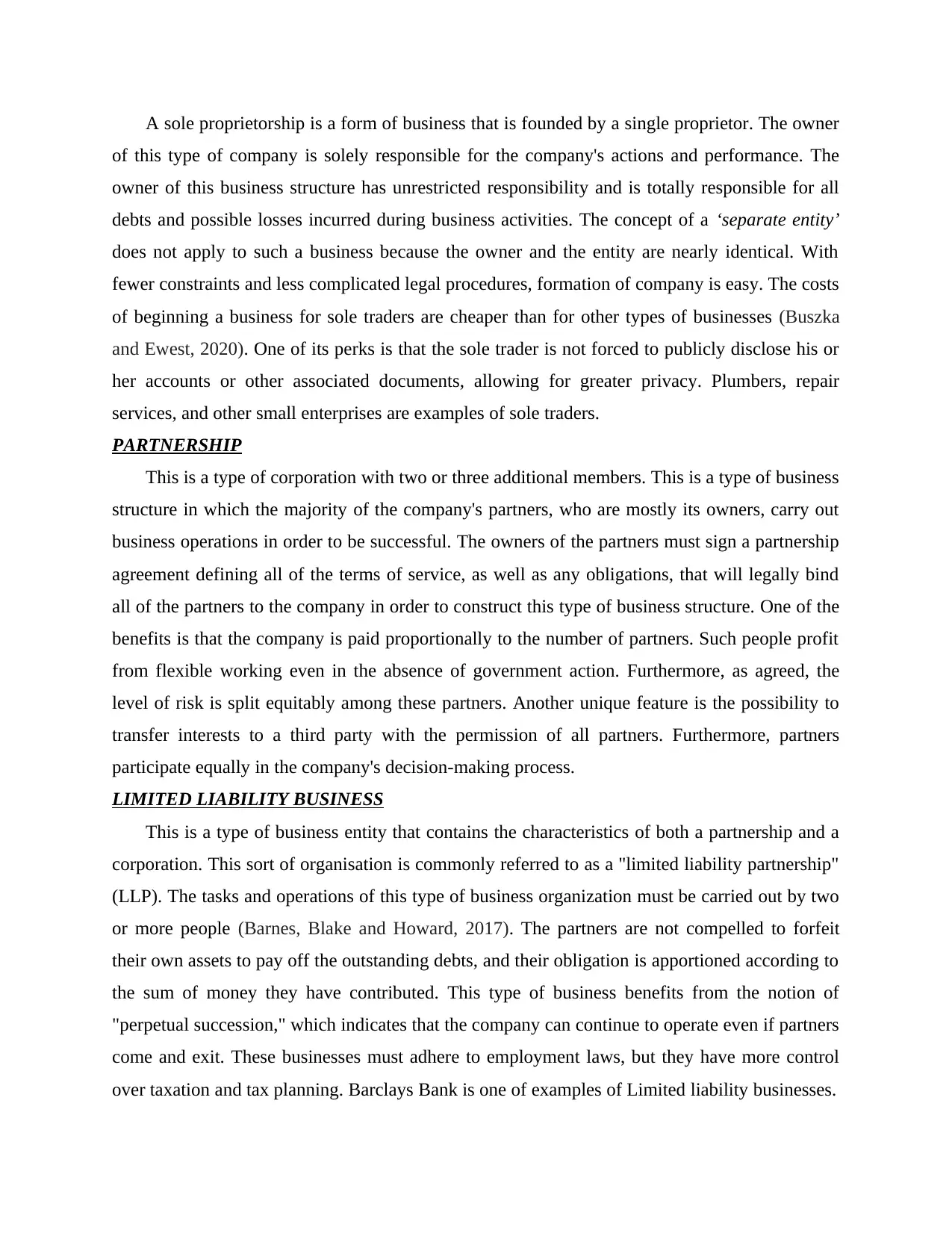
A sole proprietorship is a form of business that is founded by a single proprietor. The owner
of this type of company is solely responsible for the company's actions and performance. The
owner of this business structure has unrestricted responsibility and is totally responsible for all
debts and possible losses incurred during business activities. The concept of a ‘separate entity’
does not apply to such a business because the owner and the entity are nearly identical. With
fewer constraints and less complicated legal procedures, formation of company is easy. The costs
of beginning a business for sole traders are cheaper than for other types of businesses (Buszka
and Ewest, 2020). One of its perks is that the sole trader is not forced to publicly disclose his or
her accounts or other associated documents, allowing for greater privacy. Plumbers, repair
services, and other small enterprises are examples of sole traders.
PARTNERSHIP
This is a type of corporation with two or three additional members. This is a type of business
structure in which the majority of the company's partners, who are mostly its owners, carry out
business operations in order to be successful. The owners of the partners must sign a partnership
agreement defining all of the terms of service, as well as any obligations, that will legally bind
all of the partners to the company in order to construct this type of business structure. One of the
benefits is that the company is paid proportionally to the number of partners. Such people profit
from flexible working even in the absence of government action. Furthermore, as agreed, the
level of risk is split equitably among these partners. Another unique feature is the possibility to
transfer interests to a third party with the permission of all partners. Furthermore, partners
participate equally in the company's decision-making process.
LIMITED LIABILITY BUSINESS
This is a type of business entity that contains the characteristics of both a partnership and a
corporation. This sort of organisation is commonly referred to as a "limited liability partnership"
(LLP). The tasks and operations of this type of business organization must be carried out by two
or more people (Barnes, Blake and Howard, 2017). The partners are not compelled to forfeit
their own assets to pay off the outstanding debts, and their obligation is apportioned according to
the sum of money they have contributed. This type of business benefits from the notion of
"perpetual succession," which indicates that the company can continue to operate even if partners
come and exit. These businesses must adhere to employment laws, but they have more control
over taxation and tax planning. Barclays Bank is one of examples of Limited liability businesses.
of this type of company is solely responsible for the company's actions and performance. The
owner of this business structure has unrestricted responsibility and is totally responsible for all
debts and possible losses incurred during business activities. The concept of a ‘separate entity’
does not apply to such a business because the owner and the entity are nearly identical. With
fewer constraints and less complicated legal procedures, formation of company is easy. The costs
of beginning a business for sole traders are cheaper than for other types of businesses (Buszka
and Ewest, 2020). One of its perks is that the sole trader is not forced to publicly disclose his or
her accounts or other associated documents, allowing for greater privacy. Plumbers, repair
services, and other small enterprises are examples of sole traders.
PARTNERSHIP
This is a type of corporation with two or three additional members. This is a type of business
structure in which the majority of the company's partners, who are mostly its owners, carry out
business operations in order to be successful. The owners of the partners must sign a partnership
agreement defining all of the terms of service, as well as any obligations, that will legally bind
all of the partners to the company in order to construct this type of business structure. One of the
benefits is that the company is paid proportionally to the number of partners. Such people profit
from flexible working even in the absence of government action. Furthermore, as agreed, the
level of risk is split equitably among these partners. Another unique feature is the possibility to
transfer interests to a third party with the permission of all partners. Furthermore, partners
participate equally in the company's decision-making process.
LIMITED LIABILITY BUSINESS
This is a type of business entity that contains the characteristics of both a partnership and a
corporation. This sort of organisation is commonly referred to as a "limited liability partnership"
(LLP). The tasks and operations of this type of business organization must be carried out by two
or more people (Barnes, Blake and Howard, 2017). The partners are not compelled to forfeit
their own assets to pay off the outstanding debts, and their obligation is apportioned according to
the sum of money they have contributed. This type of business benefits from the notion of
"perpetual succession," which indicates that the company can continue to operate even if partners
come and exit. These businesses must adhere to employment laws, but they have more control
over taxation and tax planning. Barclays Bank is one of examples of Limited liability businesses.
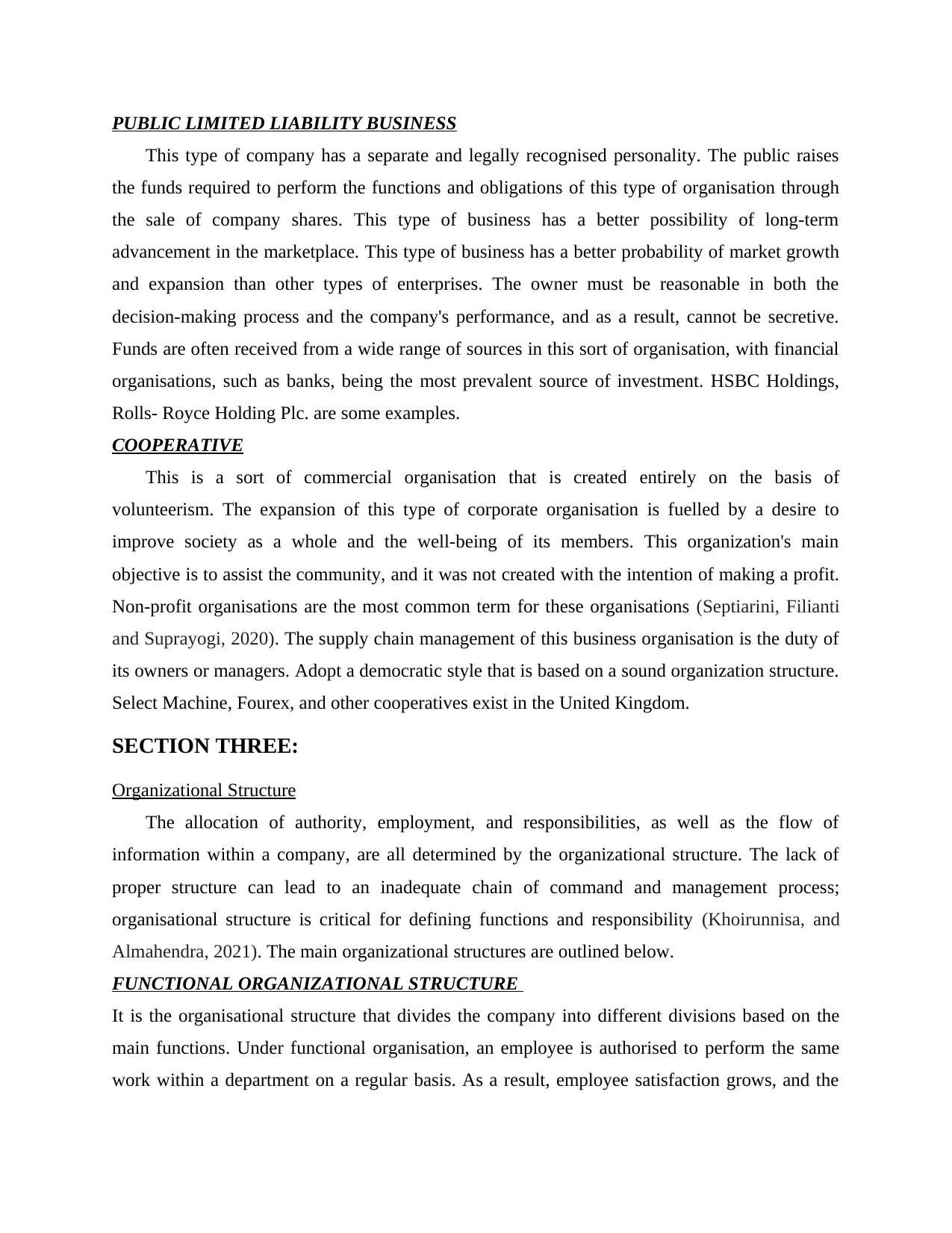
PUBLIC LIMITED LIABILITY BUSINESS
This type of company has a separate and legally recognised personality. The public raises
the funds required to perform the functions and obligations of this type of organisation through
the sale of company shares. This type of business has a better possibility of long-term
advancement in the marketplace. This type of business has a better probability of market growth
and expansion than other types of enterprises. The owner must be reasonable in both the
decision-making process and the company's performance, and as a result, cannot be secretive.
Funds are often received from a wide range of sources in this sort of organisation, with financial
organisations, such as banks, being the most prevalent source of investment. HSBC Holdings,
Rolls- Royce Holding Plc. are some examples.
COOPERATIVE
This is a sort of commercial organisation that is created entirely on the basis of
volunteerism. The expansion of this type of corporate organisation is fuelled by a desire to
improve society as a whole and the well-being of its members. This organization's main
objective is to assist the community, and it was not created with the intention of making a profit.
Non-profit organisations are the most common term for these organisations (Septiarini, Filianti
and Suprayogi, 2020). The supply chain management of this business organisation is the duty of
its owners or managers. Adopt a democratic style that is based on a sound organization structure.
Select Machine, Fourex, and other cooperatives exist in the United Kingdom.
SECTION THREE:
Organizational Structure
The allocation of authority, employment, and responsibilities, as well as the flow of
information within a company, are all determined by the organizational structure. The lack of
proper structure can lead to an inadequate chain of command and management process;
organisational structure is critical for defining functions and responsibility (Khoirunnisa, and
Almahendra, 2021). The main organizational structures are outlined below.
FUNCTIONAL ORGANIZATIONAL STRUCTURE
It is the organisational structure that divides the company into different divisions based on the
main functions. Under functional organisation, an employee is authorised to perform the same
work within a department on a regular basis. As a result, employee satisfaction grows, and the
This type of company has a separate and legally recognised personality. The public raises
the funds required to perform the functions and obligations of this type of organisation through
the sale of company shares. This type of business has a better possibility of long-term
advancement in the marketplace. This type of business has a better probability of market growth
and expansion than other types of enterprises. The owner must be reasonable in both the
decision-making process and the company's performance, and as a result, cannot be secretive.
Funds are often received from a wide range of sources in this sort of organisation, with financial
organisations, such as banks, being the most prevalent source of investment. HSBC Holdings,
Rolls- Royce Holding Plc. are some examples.
COOPERATIVE
This is a sort of commercial organisation that is created entirely on the basis of
volunteerism. The expansion of this type of corporate organisation is fuelled by a desire to
improve society as a whole and the well-being of its members. This organization's main
objective is to assist the community, and it was not created with the intention of making a profit.
Non-profit organisations are the most common term for these organisations (Septiarini, Filianti
and Suprayogi, 2020). The supply chain management of this business organisation is the duty of
its owners or managers. Adopt a democratic style that is based on a sound organization structure.
Select Machine, Fourex, and other cooperatives exist in the United Kingdom.
SECTION THREE:
Organizational Structure
The allocation of authority, employment, and responsibilities, as well as the flow of
information within a company, are all determined by the organizational structure. The lack of
proper structure can lead to an inadequate chain of command and management process;
organisational structure is critical for defining functions and responsibility (Khoirunnisa, and
Almahendra, 2021). The main organizational structures are outlined below.
FUNCTIONAL ORGANIZATIONAL STRUCTURE
It is the organisational structure that divides the company into different divisions based on the
main functions. Under functional organisation, an employee is authorised to perform the same
work within a department on a regular basis. As a result, employee satisfaction grows, and the
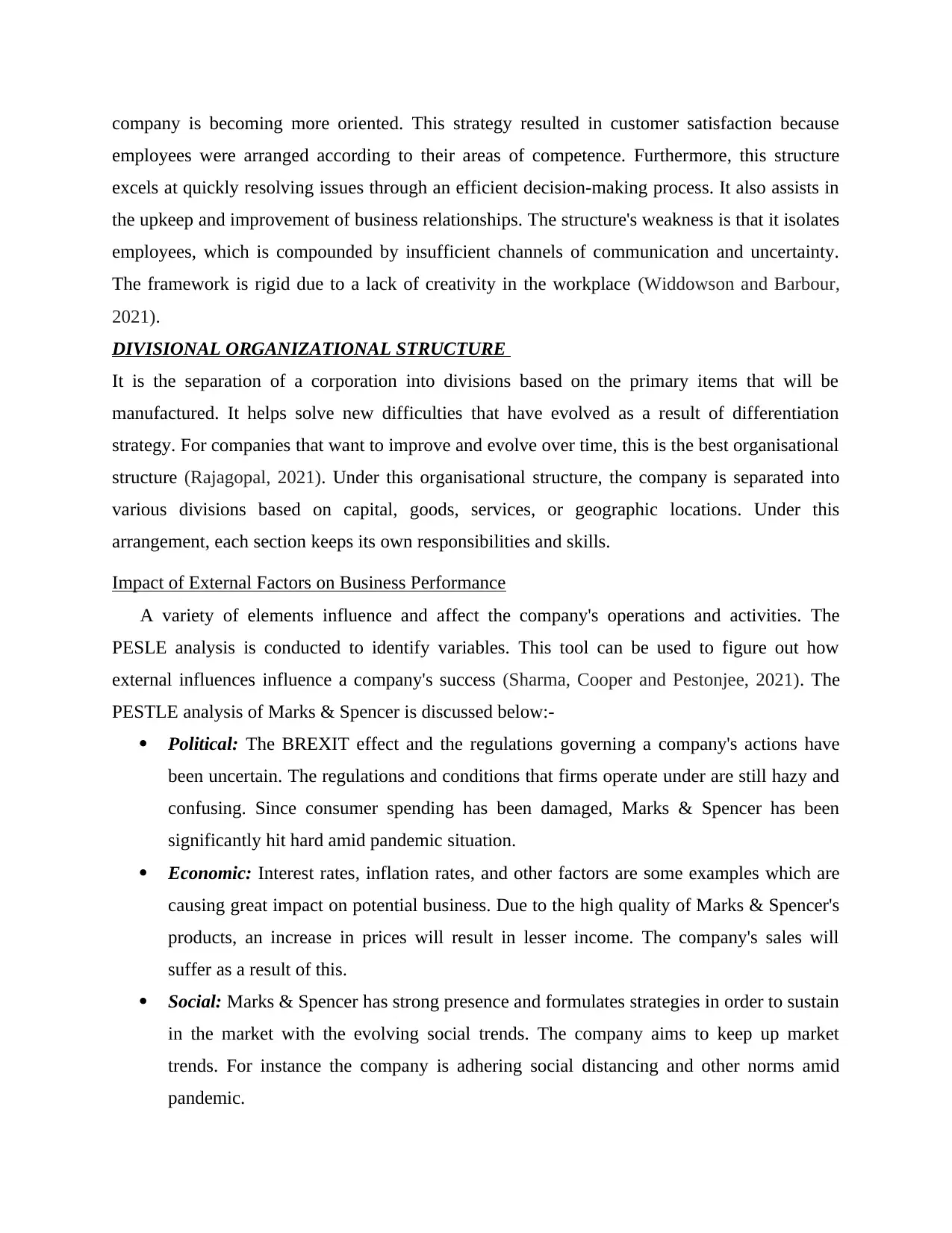
company is becoming more oriented. This strategy resulted in customer satisfaction because
employees were arranged according to their areas of competence. Furthermore, this structure
excels at quickly resolving issues through an efficient decision-making process. It also assists in
the upkeep and improvement of business relationships. The structure's weakness is that it isolates
employees, which is compounded by insufficient channels of communication and uncertainty.
The framework is rigid due to a lack of creativity in the workplace (Widdowson and Barbour,
2021).
DIVISIONAL ORGANIZATIONAL STRUCTURE
It is the separation of a corporation into divisions based on the primary items that will be
manufactured. It helps solve new difficulties that have evolved as a result of differentiation
strategy. For companies that want to improve and evolve over time, this is the best organisational
structure (Rajagopal, 2021). Under this organisational structure, the company is separated into
various divisions based on capital, goods, services, or geographic locations. Under this
arrangement, each section keeps its own responsibilities and skills.
Impact of External Factors on Business Performance
A variety of elements influence and affect the company's operations and activities. The
PESLE analysis is conducted to identify variables. This tool can be used to figure out how
external influences influence a company's success (Sharma, Cooper and Pestonjee, 2021). The
PESTLE analysis of Marks & Spencer is discussed below:-
Political: The BREXIT effect and the regulations governing a company's actions have
been uncertain. The regulations and conditions that firms operate under are still hazy and
confusing. Since consumer spending has been damaged, Marks & Spencer has been
significantly hit hard amid pandemic situation.
Economic: Interest rates, inflation rates, and other factors are some examples which are
causing great impact on potential business. Due to the high quality of Marks & Spencer's
products, an increase in prices will result in lesser income. The company's sales will
suffer as a result of this.
Social: Marks & Spencer has strong presence and formulates strategies in order to sustain
in the market with the evolving social trends. The company aims to keep up market
trends. For instance the company is adhering social distancing and other norms amid
pandemic.
employees were arranged according to their areas of competence. Furthermore, this structure
excels at quickly resolving issues through an efficient decision-making process. It also assists in
the upkeep and improvement of business relationships. The structure's weakness is that it isolates
employees, which is compounded by insufficient channels of communication and uncertainty.
The framework is rigid due to a lack of creativity in the workplace (Widdowson and Barbour,
2021).
DIVISIONAL ORGANIZATIONAL STRUCTURE
It is the separation of a corporation into divisions based on the primary items that will be
manufactured. It helps solve new difficulties that have evolved as a result of differentiation
strategy. For companies that want to improve and evolve over time, this is the best organisational
structure (Rajagopal, 2021). Under this organisational structure, the company is separated into
various divisions based on capital, goods, services, or geographic locations. Under this
arrangement, each section keeps its own responsibilities and skills.
Impact of External Factors on Business Performance
A variety of elements influence and affect the company's operations and activities. The
PESLE analysis is conducted to identify variables. This tool can be used to figure out how
external influences influence a company's success (Sharma, Cooper and Pestonjee, 2021). The
PESTLE analysis of Marks & Spencer is discussed below:-
Political: The BREXIT effect and the regulations governing a company's actions have
been uncertain. The regulations and conditions that firms operate under are still hazy and
confusing. Since consumer spending has been damaged, Marks & Spencer has been
significantly hit hard amid pandemic situation.
Economic: Interest rates, inflation rates, and other factors are some examples which are
causing great impact on potential business. Due to the high quality of Marks & Spencer's
products, an increase in prices will result in lesser income. The company's sales will
suffer as a result of this.
Social: Marks & Spencer has strong presence and formulates strategies in order to sustain
in the market with the evolving social trends. The company aims to keep up market
trends. For instance the company is adhering social distancing and other norms amid
pandemic.
Paraphrase This Document
Need a fresh take? Get an instant paraphrase of this document with our AI Paraphraser
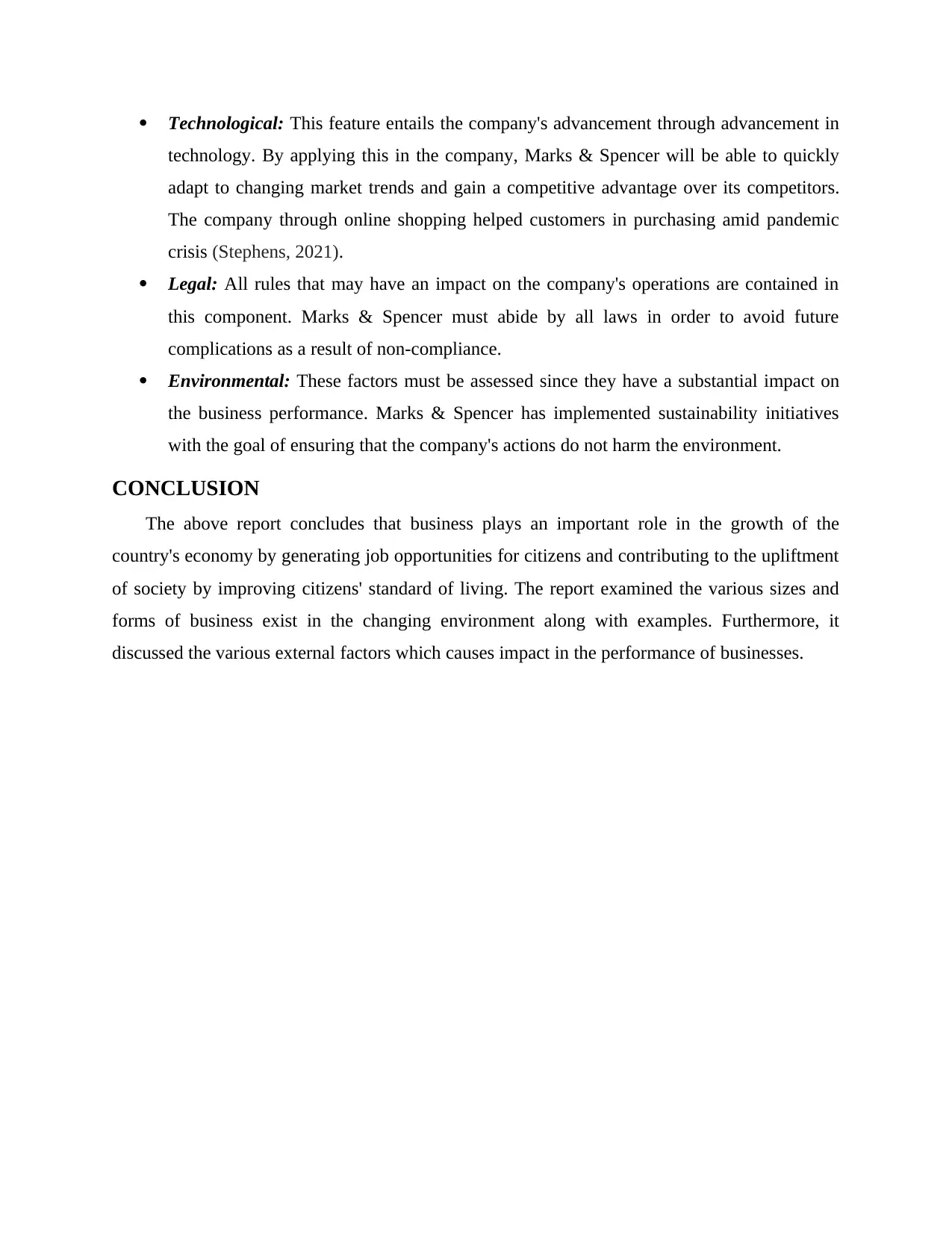
Technological: This feature entails the company's advancement through advancement in
technology. By applying this in the company, Marks & Spencer will be able to quickly
adapt to changing market trends and gain a competitive advantage over its competitors.
The company through online shopping helped customers in purchasing amid pandemic
crisis (Stephens, 2021).
Legal: All rules that may have an impact on the company's operations are contained in
this component. Marks & Spencer must abide by all laws in order to avoid future
complications as a result of non-compliance.
Environmental: These factors must be assessed since they have a substantial impact on
the business performance. Marks & Spencer has implemented sustainability initiatives
with the goal of ensuring that the company's actions do not harm the environment.
CONCLUSION
The above report concludes that business plays an important role in the growth of the
country's economy by generating job opportunities for citizens and contributing to the upliftment
of society by improving citizens' standard of living. The report examined the various sizes and
forms of business exist in the changing environment along with examples. Furthermore, it
discussed the various external factors which causes impact in the performance of businesses.
technology. By applying this in the company, Marks & Spencer will be able to quickly
adapt to changing market trends and gain a competitive advantage over its competitors.
The company through online shopping helped customers in purchasing amid pandemic
crisis (Stephens, 2021).
Legal: All rules that may have an impact on the company's operations are contained in
this component. Marks & Spencer must abide by all laws in order to avoid future
complications as a result of non-compliance.
Environmental: These factors must be assessed since they have a substantial impact on
the business performance. Marks & Spencer has implemented sustainability initiatives
with the goal of ensuring that the company's actions do not harm the environment.
CONCLUSION
The above report concludes that business plays an important role in the growth of the
country's economy by generating job opportunities for citizens and contributing to the upliftment
of society by improving citizens' standard of living. The report examined the various sizes and
forms of business exist in the changing environment along with examples. Furthermore, it
discussed the various external factors which causes impact in the performance of businesses.
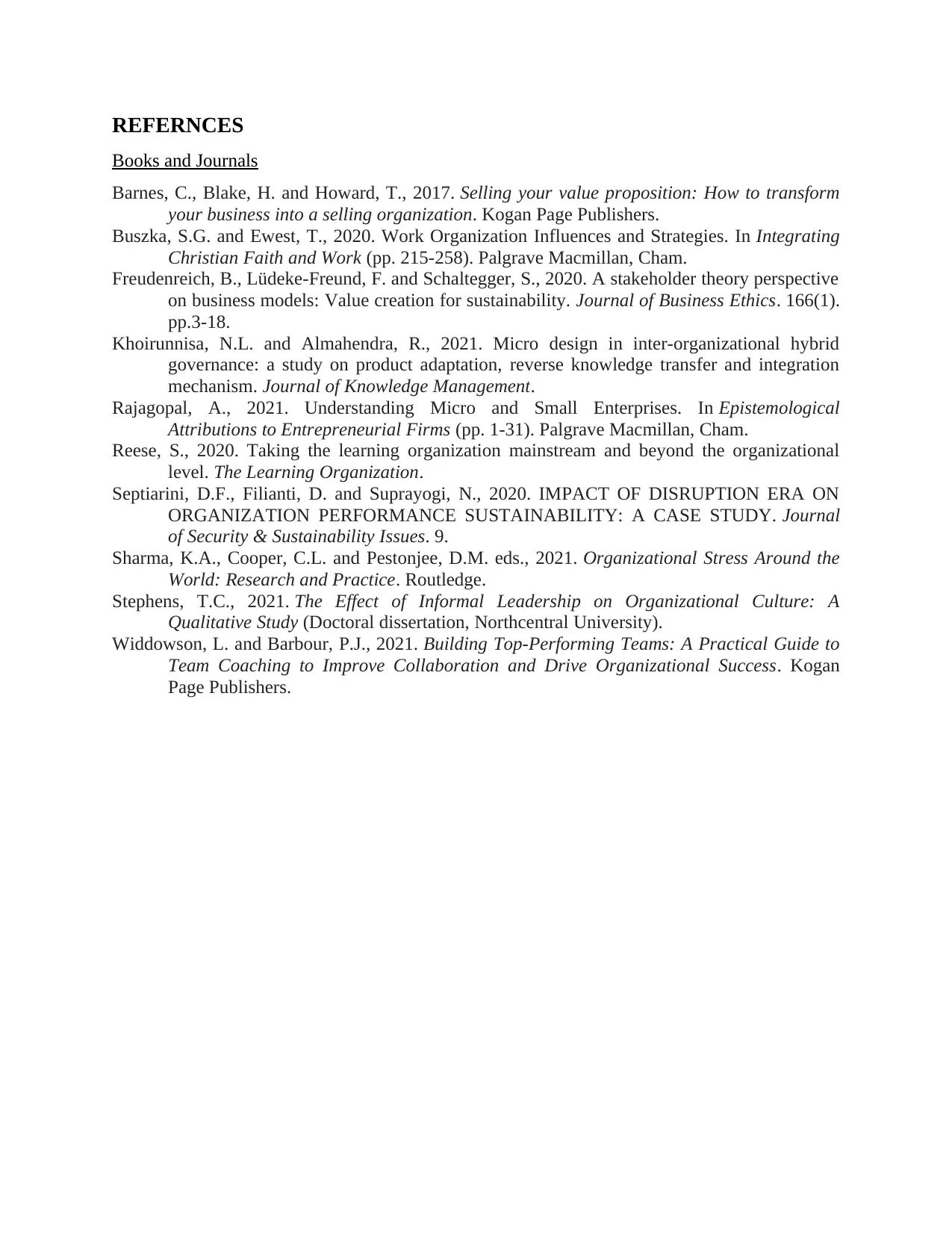
REFERNCES
Books and Journals
Barnes, C., Blake, H. and Howard, T., 2017. Selling your value proposition: How to transform
your business into a selling organization. Kogan Page Publishers.
Buszka, S.G. and Ewest, T., 2020. Work Organization Influences and Strategies. In Integrating
Christian Faith and Work (pp. 215-258). Palgrave Macmillan, Cham.
Freudenreich, B., Lüdeke-Freund, F. and Schaltegger, S., 2020. A stakeholder theory perspective
on business models: Value creation for sustainability. Journal of Business Ethics. 166(1).
pp.3-18.
Khoirunnisa, N.L. and Almahendra, R., 2021. Micro design in inter-organizational hybrid
governance: a study on product adaptation, reverse knowledge transfer and integration
mechanism. Journal of Knowledge Management.
Rajagopal, A., 2021. Understanding Micro and Small Enterprises. In Epistemological
Attributions to Entrepreneurial Firms (pp. 1-31). Palgrave Macmillan, Cham.
Reese, S., 2020. Taking the learning organization mainstream and beyond the organizational
level. The Learning Organization.
Septiarini, D.F., Filianti, D. and Suprayogi, N., 2020. IMPACT OF DISRUPTION ERA ON
ORGANIZATION PERFORMANCE SUSTAINABILITY: A CASE STUDY. Journal
of Security & Sustainability Issues. 9.
Sharma, K.A., Cooper, C.L. and Pestonjee, D.M. eds., 2021. Organizational Stress Around the
World: Research and Practice. Routledge.
Stephens, T.C., 2021. The Effect of Informal Leadership on Organizational Culture: A
Qualitative Study (Doctoral dissertation, Northcentral University).
Widdowson, L. and Barbour, P.J., 2021. Building Top-Performing Teams: A Practical Guide to
Team Coaching to Improve Collaboration and Drive Organizational Success. Kogan
Page Publishers.
Books and Journals
Barnes, C., Blake, H. and Howard, T., 2017. Selling your value proposition: How to transform
your business into a selling organization. Kogan Page Publishers.
Buszka, S.G. and Ewest, T., 2020. Work Organization Influences and Strategies. In Integrating
Christian Faith and Work (pp. 215-258). Palgrave Macmillan, Cham.
Freudenreich, B., Lüdeke-Freund, F. and Schaltegger, S., 2020. A stakeholder theory perspective
on business models: Value creation for sustainability. Journal of Business Ethics. 166(1).
pp.3-18.
Khoirunnisa, N.L. and Almahendra, R., 2021. Micro design in inter-organizational hybrid
governance: a study on product adaptation, reverse knowledge transfer and integration
mechanism. Journal of Knowledge Management.
Rajagopal, A., 2021. Understanding Micro and Small Enterprises. In Epistemological
Attributions to Entrepreneurial Firms (pp. 1-31). Palgrave Macmillan, Cham.
Reese, S., 2020. Taking the learning organization mainstream and beyond the organizational
level. The Learning Organization.
Septiarini, D.F., Filianti, D. and Suprayogi, N., 2020. IMPACT OF DISRUPTION ERA ON
ORGANIZATION PERFORMANCE SUSTAINABILITY: A CASE STUDY. Journal
of Security & Sustainability Issues. 9.
Sharma, K.A., Cooper, C.L. and Pestonjee, D.M. eds., 2021. Organizational Stress Around the
World: Research and Practice. Routledge.
Stephens, T.C., 2021. The Effect of Informal Leadership on Organizational Culture: A
Qualitative Study (Doctoral dissertation, Northcentral University).
Widdowson, L. and Barbour, P.J., 2021. Building Top-Performing Teams: A Practical Guide to
Team Coaching to Improve Collaboration and Drive Organizational Success. Kogan
Page Publishers.
1 out of 9
Related Documents
Your All-in-One AI-Powered Toolkit for Academic Success.
+13062052269
info@desklib.com
Available 24*7 on WhatsApp / Email
![[object Object]](/_next/static/media/star-bottom.7253800d.svg)
Unlock your academic potential
© 2024 | Zucol Services PVT LTD | All rights reserved.




